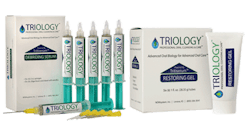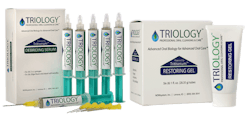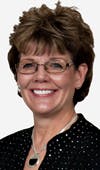Lunch and learns improve success: Implementing the Triology therapeutic dental system
If you've ever held a lunch-and-learn program at your office, you know it's almost a guarantee that something will go wrong with the schedule. In this article, Patti DiGangi, RDH, BS, explains how Triology, a manufacturer of a therapeutic dental system, has redefined lunch and learns to help dental offices implement new products.
You attended a continuing education course that rocked your world! The speaker presented different views of plaque, biofilm, and the microbiome. For a long time, those words have been used interchangeably. The oral microbiome and creating a healthy biofilm with minimal harm were newer ideas, yet they made a great deal of sense. Antioxidants have been shown to promote the wound-healing process and limit the body’s release of certain inflammatory proteins. You know having the products on hand to use and demonstrate can assist patients in changing their habits, but the challenge is to win over the rest of the team at your office.
Lessons everywhere
As a professional speaker, it’s important to me that I look my best, feel confident, and project my strongest personal brand. For me, part of that involves getting my nails done every two weeks and getting my hair done every four weeks. Recently, my salon brought in a new family of hair-care products. The display was big and colorful, and bright posters were placed around the salon. I waited and waited for my stylist to talk about these new products; she didn’t. When I finally asked which products she might recommend for me, she gave me a cursory answer with a couple of suggestions. Based on her lack of enthusiasm, I chose to buy only the smallest bottles. What a surprise—I loved the products. Yet when I thought about where I was going to purchase more, I didn’t choose my salon. I looked elsewhere because I hadn't gotten any real service at my salon.
What I wanted from my salon—specific recommendations based on my personal needs—is exactly what our patients want at our offices. Selling home-care products at a dental office makes sense. Some think that patients don’t like it when we "sell" them products. Really? We sell prophies, we sell radiographs, and we sell restorative dentistry; it’s not different.
Lunch-and-learn programs
To help dental offices successfully implement new procedures, technology, or products, many companies offer lunch-and-learn programs. A lunch-and-learn program is a training or development event scheduled during the lunch hour. Perhaps you've done them in the past.
If you've done them, you know that scheduling a program over lunch is almost a guarantee that you will run behind schedule, the first patients of the afternoon will come early, and you will not have gone to the bathroom since leaving home that morning. Not taking a break has downsides since our brains and bodies need breaks.
Different scheduling may lead to greater success. Rather than scheduling a program during lunch, you can schedule one during a patient appointment time slot and plan for everyone to attend. It will be more likely to pay off with greater success when the entire team is on the same page. Changing the common lunch and learn to a "learn without lunch" may seem strange, but the benefits will prove themselves when everyone is focused on the learning and not the lunch.
Triology redefines the lunch and learn
The way the management of biofilm is changing may also seem strange: Dentistry is shifting away from a focus on biocidal killing toward a focus on including antioxidants to balance the oral microbiome and protect oral tissues during the healing process. But often what seems strange at first becomes accepted and expected when it's been proven to be beneficial. Triology is an example of just that.
Triology is a therapeutic dental system that disrupts biofilm, increases oral wound healing, and neutralizes the free-radical activity associated with oral disease and cancer. This is quite different from our usual regimen for managing biofilm, which involves brushing with a toothpaste containing anti-biofilm agents. These anti-biofilm agents block reattachment or are biocidal, killing the biofilm's microbial community. For more recalcitrant biofilm, harsher biocides are applied via oral rinses. This scorched-earth style of treatment can damage more than just the germs.
Let’s get a bit scientifichere: Periodontal disease starts with a biofilm-based infection that creates a wound, which induces the inflammatory cascade responsible for the disease. Periodontal wounds should be taken seriously. When patients present with inflamed periodontal wounds, they are often treated without consideration of the biology of wounds and of wound healing. During the proliferation stage of wound healing, healthy granulation tissue is dependent upon the fibroblasts receiving sufficient levels of oxygen and nutrients supplied by the blood vessels. Triology does not harm fibroblasts. (1)
A recent study examined the changes in the nutrient (or antioxidant) levels of oral fluids as individuals aged. It compared 20- to 30-year-old individuals with 70- to 80-year-old individuals. The study found that individuals in their 70s had only 46% of the nutrients in their saliva, compared to those in their 20s. (2) This change, coupled with other changes in saliva as individuals age, places the elderly at a higher risk for oral cancer. The study concluded that administration of local therapeutic agents (i.e., antioxidants) to the oral cavity should be considered. (3) This is certainly a brief and over-simplified review of the study, but what this study and several other studies have shown is the need for topical application of antioxidant-rich products to prevent inflammation in the oral cavity—especially as individuals age. Triology products are new weapons we can use to allay the effects of aging and achieve better health without destruction.
Here’s where the "sales" part gets a bit tricky . . . how do you communicate the need for these products to your patients without sounding like a Wikipedia page? Enter your support team of Triology experts and their focused approach, the "learn without lunch." It takes a bit of time and focus, but the Triology team knows that, and they work with you on more than just the application of the products.
First of all, it’s important that everyone understands the benefits of using antioxidants in oral care therapies. Everyone needs to feel comfortable having conversations about it with their patients—real conversations, not just "Yeah, they’re great, and you should try them." That’s why Triology uses a focused learn-without-lunch approach. The goal is for you to feel comfortable and confident discussing another way of managing biofilm with your patients, even if it seems strange at first.
The Triology team uses their time in the dental office to educate your team about the science and help you develop an understanding of how the components of the system work together. They complete the program by helping the entire professional team select the most appropriate patients from the upcoming schedule to ensure they are able to experience the full benefits of the system. Through Triology's focused and interactive approach, dental professionals can become much more equipped to have conversations with their patients about why and how the products should be used at home. Your team will develop the skills to offer patients a learning experienceinstead of a sales experience.
First step on a journey
Making changes in the way your team learns and embracing the benefits of including new therapies, such as antioxidants, in your patients’ care may seem strange today, but working with companies (like Triology) that use interactive learning events will shorten the time your team needs to feel comfortable and confident when making changes.
Just like with my stylist, our patients want and expect our expertise. They want us to make specific recommendations based on their personal needs. Our ongoing success requires all team members to participate and to be confident about their knowledge.
Editor's Note: This article first appeared in Pearls for Your Practice: The Product Navigator. Click here to subscribe. Click here to submit a products article for consideration.
References
1. Bowen J, Cole C, and McGlennen R. Comparison of Antimicrobial and Wound Healing Agents on Oral Fibroblast Viability and In-vivo Bacterial Load. Dentistry. 2015;5:305.
2. Hershkovich O, Shafat I, Nagler RM. Age-related changes in salivary antioxidant profile: possible implications for oral cancer. J Gerontol A Biol Sci Med Sci. 2007;62(4):361–366.
3. San Miguel SM, Opperman LA, Allen EP, Zielinski J, Svoboda KK. Bioactive antioxidant mixtures promote proliferation and migration on human oral fibroblasts. Arch Oral Biol. 2011;56(8):812–822.


